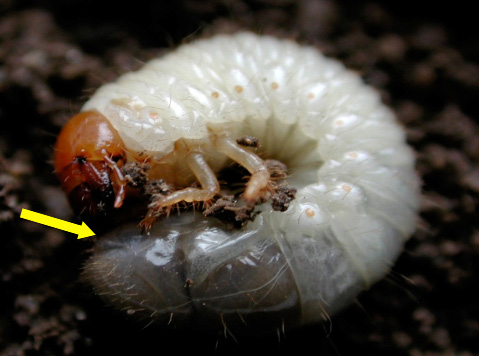What are White Grubs?
Above: Purdue Extension photo depicts raster patterns of several species of white grub larvae. Photo from Purdue Extension publication E-271-W.
One issue that homeowners occasionally have to deal with is white grubs chewing on grass roots. The result is a dead patch in the lawn that grows in size. What are white grubs and where do they come from?
White grubs are white, C-shaped larvae that are the immature life stage of various scarab beetles. They have a chestnut-colored head, with three sets of legs near the head. Different species will vary in size. Older larvae may be from ¼ to 1½ inches in length. Besides affecting lawns, they can also be a pest of other horticultural and agricultural crops.
Scarab beetles that produce white grubs include the Japanese beetle, two species of masked chafer, European chafer, Asiatic garden beetle, Oriental beetle, green June beetle, several species of May/June beetles, and black turfgrass ataenius. The two most common white grub species I have observed affecting lawns locally are the Japanese beetle and the masked chafer.
If they are all basically a curved, white worm, how to entomologists tell them apart? Not to be too graphic with you, but they look at the patterns of hairs on their raster (the posterior end of the white grub). This pattern is somewhat like a fingerprint for the various species of white grubs.
Douglas Richmond, Professor and Turfgrass Entomology Extension Specialist, authored a Purdue Extension publication on white grubs.
“Proper identification and basic understanding of the varying life cycles of different white grub species can help turfgrass managers monitor, plan for and manage infestations,” he said. “A hand lens, magnifying glass or microscope may be required to see the [raster] pattern clearly.”
He said that the life cycles of these insects can be grouped broadly into three categories (annual, semi-annual, and multi-annual) based on the amount of time required to complete development. “Annual white grubs are the most common pest species, producing one generation every year,” he said. “Several annual white grubs species (Japanese beetle, European chafer, Asiatic garden beetle, and Oriental beetle) are considered exotic, invasive species, but others are native to North America (masked chafers, green June beetle).
The black turfgrass ateanius is a semi-annual white grub that produces two generations per year. “This species is not known to damage lawns, but is capable of causing serious damage to closely mowed, golf course turf,” said Richmond.
Several species of May/June beetles are multi-annual species, and they occasionally damage home lawns. “These insects require 2-3 years to complete development, based on latitude,” he said. “As their name implies, overwintering adults emerge during May and June.”
Richmond said that white grubs are capable of causing serious damage to turfgrass. “Their feeding and mining activity damages plant roots, causing the turf to wilt and die,” he said. “Early indications of grub damage may include patchy areas of wilting, discolored or stressed turf that does not respond to irrigation.” He added that wilting turf may take on a blue or purple cast before collapsing to form dead or extremely thin patches that may range in size from a few yards to large contiguous areas. Within these areas, sod can easily be pulled up or pulled back like a carpet, with white grubs beneath. Grubs will tend to be more numerous at the transition from dead to normal turf.
Heavily infested turf may attract raccoons, skunks, or wild turkeys that will forage for the grubs and make a mess of the lawn.
White grub management includes one of several tools that can be considered, including cultural practices, biological insecticides, insect-parasitic nematodes, insect-pathogenic bacteria, entomophagous fungi, and chemical insecticides. Insecticide use may focus on preventive, early curative, or late curative (rescue) treatments.
For annual white grubs, such as Japanese beetles and masked chafers, preventive insecticides are deployed from May through June. Early curative insecticides focus on July and August, while late curative products are used from mid-August through early November.
“Adults emerge and fly during early- to mid-summer and begin laying eggs in the soil,” said Richmond. “Eggs hatch by the end of July producing small larvae that begin feeding in the root zone.” He said that large larvae are usually present by September, but damage may appear anytime between August and November. He added that the adults of some species (e.g., Japanese beetle, Asiatic garden beetle) can be serious pests of ornamental plants.
A commonly held belief posits that if you control white grubs, you will control moles. Grubs comprise only a portion of the moleʼs diet, which also includes earthworms and other soil animals. So, moles can and are present in grub-free lawns.
For details on possible management tools, consult Richmond’s publication, “Managing White Grubs in Turfgrass,” available at www.edustore.purdue.edu.

White grub. Arrow points out the location of the raster.
Photo by Purdue University, Purdue Extension Publication E-271-W.
